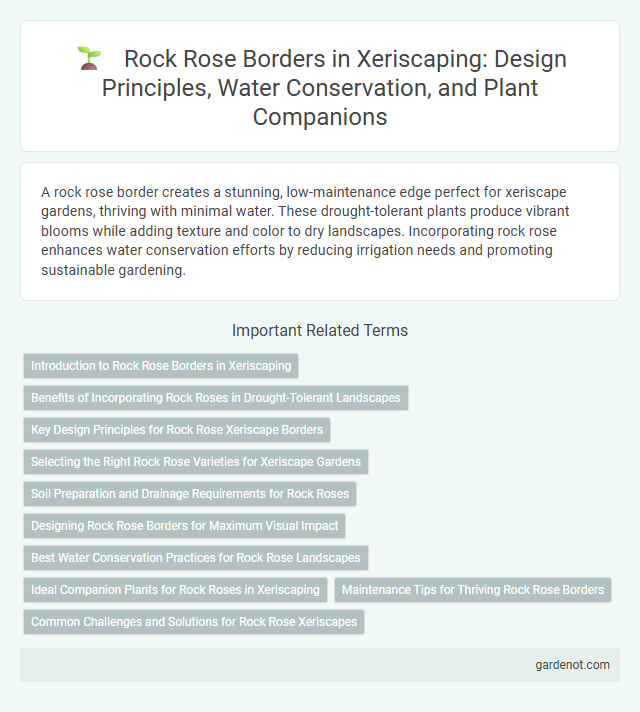A rock rose border creates a stunning, low-maintenance edge perfect for xeriscape gardens, thriving with minimal water. These drought-tolerant plants produce vibrant blooms while adding texture and color to dry landscapes. Incorporating rock rose enhances water conservation efforts by reducing irrigation needs and promoting sustainable gardening.
Introduction to Rock Rose Borders in Xeriscaping
Rock rose borders are an essential element in xeriscaping, providing drought-tolerant beauty with minimal water requirements. These evergreen shrubs thrive in well-drained, rocky soils, making them ideal for water-efficient gardens in arid climates. Their vibrant blooms and low maintenance needs enhance landscape aesthetics while conserving water resources.
Benefits of Incorporating Rock Roses in Drought-Tolerant Landscapes
Rock rose borders enhance drought-tolerant landscapes by offering exceptional water efficiency and resilience in arid conditions. Their deep-root systems reduce soil erosion while providing vibrant, long-lasting blooms that attract pollinators such as bees and butterflies. Incorporating rock roses supports sustainable gardening practices and minimizes irrigation needs, promoting environmental conservation in xeriscape design.
Key Design Principles for Rock Rose Xeriscape Borders
Rock rose xeriscape borders thrive with key design principles emphasizing drought-tolerant plant selection, strategic spacing to reduce water competition, and layering with complementary textures to enhance visual appeal. Incorporating porous, well-draining soil and using mulch to retain moisture further supports plant health while minimizing irrigation needs. Integrating sun exposure patterns and seasonal blooms ensures year-round interest and sustainability in water-wise landscaping.
Selecting the Right Rock Rose Varieties for Xeriscape Gardens
Choosing drought-tolerant rock rose varieties such as Cistus purpureus and Cistus ladanifer enhances xeriscape garden sustainability by conserving water and adding vibrant blooms. These species thrive in well-drained, rocky soil with full sun exposure, making them ideal for arid landscapes. Selecting cultivars with varying flower colors and growth habits allows for a dynamic, low-maintenance border that complements xeriscape principles.
Soil Preparation and Drainage Requirements for Rock Roses
Rock rose (Cistus spp.) thrives in well-drained, sandy or rocky soils that mimic its native Mediterranean environment. Effective soil preparation involves loosening the soil to improve aeration while ensuring it remains gritty and free of heavy clay or excessive organic matter, which can retain moisture and promote root rot. Proper drainage is critical; raised beds or sloped areas help prevent waterlogging, supporting healthy root development and sustained growth in xeriscape gardens.
Designing Rock Rose Borders for Maximum Visual Impact
Design rock rose borders by arranging varying heights and vibrant colors to create depth and contrast, ensuring continuous blooms from spring through fall. Incorporate complementary drought-tolerant plants like lavender and ornamental grasses to enhance texture and attract pollinators. Use natural stone edging or gravel mulch to define the border while maintaining moisture retention and minimizing upkeep.
Best Water Conservation Practices for Rock Rose Landscapes
Rock rose (Cistus spp.) thrives in xeriscape gardens due to its drought tolerance and low water requirements, making it ideal for water conservation landscapes. Employing mulch around rock rose borders minimizes evaporation and maintains soil moisture, while drip irrigation targeted at the root zone reduces water waste. Selecting native rock rose varieties adapted to local climates further enhances water efficiency and sustainability in xeriscape designs.
Ideal Companion Plants for Rock Roses in Xeriscaping
Rock roses thrive in xeriscape gardens when paired with drought-tolerant companions such as lavender, yarrow, and sedum, which enhance their visual appeal and conserve water. These plants share similar soil and sunlight requirements, ensuring a harmonious, low-maintenance landscape. Incorporating ornamental grasses like blue fescue or creeping thyme further complements the rock rose border, adding texture and seasonal interest.
Maintenance Tips for Thriving Rock Rose Borders
Rock rose borders thrive best with well-drained soil and full sun exposure, ensuring their drought-tolerant nature is maximized. Prune spent flowers and dead stems regularly to encourage vigorous growth and maintain a neat appearance. Applying a layer of mulch helps retain soil moisture while suppressing weeds, reducing the need for frequent watering and upkeep.
Common Challenges and Solutions for Rock Rose Xeriscapes
Rock rose xeriscapes often face challenges such as poor soil drainage, which can lead to root rot, and susceptibility to fungal diseases during humid conditions. Ensuring well-drained soil with added grit or sand and providing adequate air circulation through proper plant spacing mitigates these issues. Regular pruning and avoiding overhead watering further reduce fungal risks and promote healthy growth in rock rose borders.
Rock rose border Infographic

 gardenot.com
gardenot.com